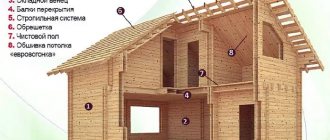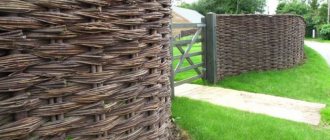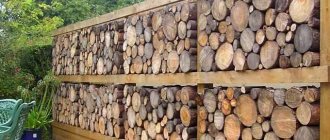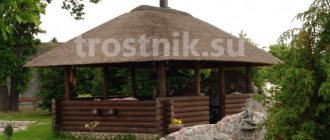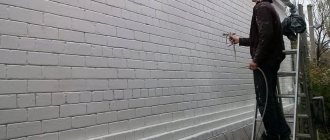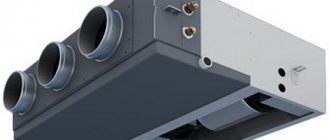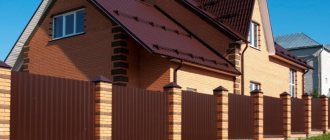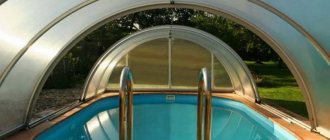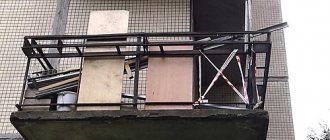Country houses today are no longer the modest wooden huts that we usually imagine when we say the word “dacha”. These are spacious cottages in styles ranging from minimalism to barnhouse. And the fences match them - strict shapes, durable materials, original designs. See for yourself!
It is rare that the owner of a private house today approaches the fencing of a property according to the principle “made from what was there” - most understand that the fence is, if not the “face” of the house, then certainly part of the architectural composition. It is the fence that is first seen by your neighbors and friends who decide to stop by for a visit. So the right approach is to try to make this first impression as pleasant as possible.
If 20 years ago the most common option for a dacha fence was a wooden picket fence, then modern dachas can boast a wide variety of materials - from new ways of using the same wood to the most unusual combinations, for example, metal with gabions. Some fences are a real work of art!
Let us consider in detail the different types of materials for creating a fence, the technologies for their use, and talk about the pros and cons of each type of fencing.
Metal picket fence (Euro picket fence)
Metal picket fence is one of the most popular materials for building fences today. It is affordable, easy to install, and allows you to create a strong and durable fence.
A Euro picket fence is a structure that combines three types of elements: support posts, 2-3 transverse joists and metal strips attached to them. Pickets can have a height from 1.5 to 2 m, the width varies, but the optimal parameter is 120 mm, the shape also comes in different shapes - M-shaped, U-shaped or semicircular.
The strength of the planks is determined by the height of the profile and the thickness of the metal from which they are made, and their durability is determined by the applied coating. Metal strips can be galvanized (this is the most inexpensive option), painted with glossy or matte powder paint, or coated with a polymer composition, which makes the material more expensive, but extends its service life to 50 years.
The pickets are attached to the joists using self-tapping screws or special rivets - even a non-professional can assemble such a fence. The planks can be mounted closely or with a gap between them. To ensure greater security and privacy, they often choose a double-sided staggered fastening method - such a fence will be more expensive, but will look neat on both sides, and will also better protect the area from the wind and prying eyes.
The main parameter that affects the price and service life of a Euro picket fence is its coating.
- Simple galvanized metal strips will cost 30% less and will last 10-15 years.
- Pickets, painted in standard colors (gray, brown) with glossy or matte paint, are in the average price range and retain their working qualities for up to 20-30 years.
- The most expensive and durable would be a fence made of pickets coated with a protective layer of pural, plastisol or PVDF. Pickets with such a coating can last 50 years or more.
You can choose a European picket fence with a decorative wood-look coating - this is also a strong and durable option, which is achieved thanks to the technology of applying a pattern. The galvanized steel sheet is coated with a primer, polyester, a pattern is applied to it, which is protected on top with a polymer - a six-layer coating is obtained that ensures resistance to damage.
So, to summarize: what are the advantages and disadvantages of a metal picket fence?
pros:
- durability of the structure (minimum service life 15-20 years);
- simplicity and speed of installation;
- large selection of coatings and colors, different design options for sections;
- good air exchange and light transmission (when installing pickets in one row, there will be enough light for plants planted near the fence);
- lack of special care, ease of repair;
- resistance to any external influences, including fire;
- wide price range.
Disadvantages (manifest when trying to reduce the cost of the design):
- high visibility of the area when the planks are installed in one row with gaps;
- inexpensive galvanized euro picket fence is less resistant to corrosion;
- wide slats made of thin metal (0.45 mm) can deform under load and are less resistant to wind;
- vertical installation of a large number of elements requires strict adherence to the level, which can cause difficulties if there is no experience.
Features of design solutions
The simplest way out is polymer tiles with a natural texture, laid on a simple square pillar, with a unique completion of the composition (spire, cone, spear tip). All materials are inexpensive, installation processes are simple, but this decor looks rich and fits perfectly into classic, rustic and even modern styles.
A traditional corrugated sheet with brick pillars can be improved by simple forging or cheap casting; a shaped and original version, a border on the sheet or beautiful fasteners is not necessary. Plaster casting, flower pots, stylized Greek frets, pedestals and corner trestles will make the lower horizontal row spectacular and lengthen the fence installed in the upper one.
A private house not built according to a standard design requires fencing as the completion of the design structure. The adjacent territory cannot be limited by a simple and primitive fence if the house is built pompously and beautifully, with numerous decorative attributes.
Fence-blinds
A metal fence made of horizontal slats, the so-called jalousie fence, is essentially a variant of using the same European picket fence. However, companies offering turnkey fence installation services usually highlight this type as a separate one. This is because not only metal, but also wooden slats can be used to make such a fence. In addition, they are often sold in the form of ready-made sections that are easy to install on the site yourself.
Metal slats for fence-blinds are made from galvanized steel profiles, which are given a special shape in the factory and covered with a protective polymer layer. These slats are installed at a certain angle, which ensures ventilation of the area, but at the same time reliably protects it from prying eyes.
The components of such a fence (slats, pillars, finishing U-planks, parapets for a concrete foundation) are coated with glossy or matte paint of any color, and can also have a Printech coating, depicting the texture of wood.
When constructing a fence from horizontal slats, the thickness of the metal from which they are made matters. If for a vertical picket fence less than 2 m long, a metal thickness of 0.45-0.5 mm is considered suitable, then horizontal installation requires stronger steel - it is advisable to choose a thickness of 0.6-0.7 mm.
Before installation, wooden slats must be sanded and treated with protective impregnation - this will increase resistance to impacts and extend the service life of the fence. We will tell you more about the use of wood in the construction of fences in a separate chapter, but for now we will name the main advantages of a metal shutter fence.
pros:
- reliability and durability (lamellas with a protective polymer coating last from 30 to 50 years);
- original and modern appearance;
- ease of installation (assembly is carried out using a screwdriver or riveter);
- high ability to transmit light and air, with good sound insulation,
- resistance to environmental influences (humidity, precipitation, temperature changes);
- low cost (compared to a stone or brick fence);
- fire safety.
disadvantages to such a fence; the only disadvantage (with a stretch) can be considered that if the protective coating is damaged, the metal elements will be susceptible to corrosion.
Fencing functions
A fence is an integral part of every territory. It does not matter what exactly is located in this area. In any case, the fence performs a number of basic tasks. These include:
- Perimeter security. Perhaps this is what home owners focus on to a greater extent. A high solid fence will make it difficult for unauthorized persons to enter your territory. A properly installed fence will also protect the perimeter from encroachment by pest animals.
- Home decoration. The fence complements and improves the composition of your estate. The overall panorama looks finished and well-groomed. The attractive appearance of a fence can distract the attention of passers-by from the shortcomings of the territory of the house or the decor of the building itself.
- Site confidentiality. Not all fences have this function. Blank types of walls allow you not to advertise what is happening on the site. Partially, the confidentiality point has something in common with the first function. Protecting privacy can discourage intruders from crossing this type of fence.
- Improves the atmosphere. Modern fences are produced in various colors, designs, and styles. This opens up space for experimentation and giving the environment a positive feel.
- Status appearance. For some this is a controversial point. However, a nice original fence will cement your status as an ambitious homeowner. There is no need to choose exclusively the most expensive types of materials - a rich effect is achieved with a laconic form and bold decorative solutions.
Expert opinion
Vladimir Ulyanov
I have been involved in fences for over 10 years, answering questions and helping people cope with the installation task on their own.
Ask a question to an expert
The specific type of fencing is responsible for the complete performance of these functions. Some species meet two points, while others answer all of the above.
Below we will analyze the characteristics of fences using exact examples.
Fence made of corrugated sheets (metal profiles)
A fence made of corrugated board can compete with a European picket fence in its popularity. This material cannot be called ultra-modern, but it is often chosen for the construction of fences in country houses and private estates. The reason is the optimal price-quality ratio.
A fence made of metal profiles has good noise insulation due to the use of solid sheets, and in terms of durability it is not inferior to other types of metal fencing. Its strength is determined by the height of the ribs, the thickness of the material and the type of coating (galvanized, painted or polymer layer).
The installation of such a fence can be continuous or sectional, and it is not difficult to do it yourself. In case of continuous installation, the support pillars are installed at a distance of 1.5-2.5 m, and sheets of corrugated sheets are attached to them with an overlap. As a result, the fence is a solid metal wall. With the sectional installation method, the sheets are installed in the spans between the pillars, which can be made of concrete, brick, stone or metal with forged elements.
To attach metal profiles to poles, experienced builders recommend using roofing screws - they have a neoprene rubber gasket, which allows them to tightly press the sheet to the support without damaging the surface and thereby preventing moisture from entering the holes.
- A fence made of brick and corrugated board: how to make it yourself quickly and inexpensively
Learn about the intricacies of constructing a practical fence for a suburban area.
Let us list the advantages and disadvantages of this type of fencing.
pros:
- long service life (galvanized sheets last up to 30 years, covered with a polymer protective layer - up to 50 years);
- a large selection of design options - from painting in different colors to imitation brickwork or wood;
- weather resistance;
- good sound insulation;
- fire safety;
- low cost;
- no need for regular care.
The disadvantages are minor compared to the price, but they still exist:
- high windage of solid metal sheets (instability to gusts of wind);
- rust may occur if the protective layer is damaged;
- rather cumbersome design;
- impenetrable to air and sunlight.
- What to plant in the shade near the fence: 6 plants for lovers of coniferous and deciduous crops
We choose shade-loving and shade-tolerant plants for an ever-dark corner in the garden.
- How to decorate a corrugated fence from the site side
Tired of a plain fence made of profiled sheets? Consider different options for improving it without outside help.
Installation Tools and Materials
To install the fence at the selected location, you will need to prepare the following tools and materials:
- A garden auger powered by muscle force or mechanical drive. It is used to drill foundation holes for installing a fence. The diameter of the drill exceeds the diameter of the installed supports.
- A measuring tool, with its help they mark out the area and correctly install the metal fence with their own hands.
- Of course you will need sand and cement. They are needed to make concrete mortar, which will be poured into the foundation pits after installing the pillars.
Wooden fence
At all times, wood retains its position as a favorite and frequently used material for the construction of fences. In modern fences it no longer plays the “first fiddle”, but creates the impression of naturalness and environmental friendliness, and closeness to nature is one of the powerful trends that is gaining popularity.
Lovers of natural materials often choose edged boards, wooden slats and slats for building a fence, but in modern versions they are placed in an original way and combined with other types (stones in gabions, metal frames, pillars made of brick and concrete). Rounded, profiled or laminated timber is used for the construction of section frames and as raw materials for pillars.
To increase their service life, all wooden elements of fencing need to be impregnated with special compounds - antiseptics, primers. It is recommended to carry out such treatment once every 2-4 years.
A wooden fence can look ultra-modern - for example, in combination with black steel frames, or it can be stylized as an American ranch or farmhouse. It all depends on the width of the boards used, their location, processing and finishing coating.
Wooden elements are especially often used in the construction of fencing for houses in the modern barnhouse style (from the English barn - barn).
- Wooden fence: the most beautiful and unusual ideas
Thinking about which fence to choose for your site? We would like to offer you more than 20 interesting photo ideas.
The price of a wooden fence will depend on the type of wood, its quality and processing method, as well as the complexity of the design. If you are inclined to this option, consider all its pros and cons.
pros:
- environmental friendliness,
- availability and low price of the material,
- ease of installation,
- a large field for design experiments.
Minuses:
- the main disadvantage of a wooden fence is its susceptibility to environmental influences (weather phenomena, insects);
- The second disadvantage follows from the first - the need for regular maintenance of a wooden structure (without a protective coating it will last no more than 5-10 years);
- easy flammability.
How to install pillars?
The following methods are used to install metal fence posts. The pillars are installed in pre-prepared holes, into which, after installing the supports, concrete is poured.
In addition to this method, piles are often driven into the ground. For this purpose, special pointed pillars are used.
Another method came from the method of making a foundation on screw piles. That is, screw blades are welded onto the supports that need to be installed for the construction of the fence, allowing them to be installed in place by screwing them into the ground at the location specified in the project for the construction of the fence.
Useful Beautiful options for fences made of corrugated sheets for private houses
Mesh fence
The most inexpensive material for limiting the contours of a site is mesh. If a dozen years ago, summer residents most often chose a simple chain-link mesh for fencing the far corners of the garden (it is customary to build more impressive structures in the façade), today other options for this inexpensive but practical material have appeared. And they can look quite modern!
For example, the so-called euro mesh, coated with a polymer composition to extend its service life, has appeared on sale, as well as a gitter mesh (or 3D mesh), which we will talk about in more detail.
Gitter mesh is a frame made of low-carbon steel wire, which is coated with a polymer layer for durability. Under this layer, the steel can be additionally reinforced by hot-dip galvanizing - such a mesh will not rust if the protective coating is damaged and will generally last longer. But even a non-galvanized sheet with a PVC layer can maintain its appearance and functionality for 10 years.
Most often, 3D mesh is offered in the form of ready-made sections for quick installation; posts and fasteners are supplied with them. This type of fencing is convenient to use in areas with difficult terrain, because The spans can be adjusted in height, building a multi-level structure.
Advantages of a 3D mesh fence:
- high strength and rigidity of the structure (welded mesh does not sag over time and is not afraid of gusts of wind);
- durability and resistance to impacts (galvanized steel plus a protective layer equals operation for up to 50 years);
- ease of installation and adjustment;
- translucency and breathability;
- no need for care;
- low price.
any downsides , except, perhaps, the inability to hide behind such a fence from neighbors and the prying eyes of passers-by. But this, firstly, is not always necessary, and secondly, it can be solved by planting fast-growing shrubs and climbing plants along the fence.
- 11 plants that will disguise an unsightly fence and significantly transform the area
Review of popular climbing plants and the secrets of their cultivation.
One of the original ways to decorate an old fence or hide the unsightly side of a newly installed one can be a photo grid - reinforced PVC material with a pixelated pattern applied to it. This fabric is easily attached to the spans of the fence using decorative rings and allows you to reproduce absolutely any pattern.
- Photo grid in landscape design: what is it and what is it for?
If your fence is already pretty worn out by time, a photo grid will help give it a second life.
Frame painting
Before screwing in the corrugated sheet, the racks and cross members must be treated with anti-corrosion primer and painted twice with façade paint.
Applied drawings
Modern technologies make it possible to create sheet metal simulating the textures of wood or stone. Fences made of such materials look unusual and attract attention. Corrugated sheeting that imitates the structure of wood adds comfort to the design of the room. This material combines well with brickwork and harmonizes with plants.
When building a fence, it is necessary to study the color palette of profiled sheets offered by manufacturers. Smooth shiny metal combines with different materials:
- Stone.
- Brick.
- Tree.
- Specific.
Sandstone, tuff and dolomite are often found in profiled slab designs. The design of a fence with such an image looks solid and expensive. When choosing a pattern, you should take into account the material of the walls and the decorative ornament of the facade of the house. The combination of the same colors and materials will connect the house with its fence into a single architectural ensemble.
If desired, you can order corrugated cardboard with a special pattern applied. The customer just needs to provide samples of images of nature, animals or ornaments, and they will be transferred to the sheet by photo printing.
Those who like to decorate the fence of a private house with their own hands use self-adhesive film. It may contain images of flowering shrubs, landscapes, and ornaments. It is necessary to glue the film to the profile, gradually pressing it against the textured surface.
For artists and only those who love to draw, creating paintings with oil paints is suitable. Experts can create a natural landscape. For fans, cartoon characters and children's drawings, as in the photo below, will look original.
Color options
During the production process, galvanized corrugated sheets are coated with a polymer layer, which performs protective functions and imparts color. This coating does not fade when exposed to sunlight and retains its original appearance for a long time. A rich color palette makes it easy to choose a shade of material that will harmonize with the atmosphere of the house and site.
Calm tones are popular: brown, red, beige, gray. This color combination is appropriate in any interior. A white hedge looks fresh and will become a real decoration of the dacha. The black color gives it a strict and solid look, but a dark fence requires more careful maintenance, as dirt is more visible on it.
The bright color scheme amazes the imagination with a riot of colors - rich burgundy, exquisite green, luxurious blue and bright shades of yellow wavy fence will transform your mood. Rich tones can be combined with home decor elements such as rooftops or garden decorations. A striking fence can also act as an accent.
Related products
To simplify the installation and operation of U-shaped fence strips, you may need additional products:
- Repair enamel . It will be useful if you need to treat a damaged area of a polymer coating. It can also be used to process cut edges of products. Enamel protects the metal from corrosion.
- Self-tapping screws 4.8x19/4.8x28/5.5x19 mm with EPDM gasket . They will be needed to connect the elements of the fence frame to each other.
- Self-tapping screws 4.2x16 mm with press washer. They are used for a more aesthetically pleasing fence, since such screws are almost invisible against the general background. There are several options:
- with a drill (for working on metal up to 2 mm);
- sharp (for working on metal up to 0.9 mm).
Picket fence device
Paint the bottom of the post with oil paint. You can fill them with crushed stone, stone or fill them with cement to strengthen them.
If you do not need extra shadow, but at the same time protection from animals is important, then a type of fencing such as a picket fence is recommended. It has different designs, and the pillars can be made of different materials - metal, brick, wood. The height of the picket fence is usually 50-90 cm. Its installation is as follows:
- Mark the holes for the posts using a string. Pull the cord using two strips at a distance of 3 m from each other.
- Dig holes for the posts (about a meter). Install the corner posts first, then install the rest using string.
- Fill the gap between the pit wall and the post with sand.
- Nail slats along the cord onto the wooden purlins between the posts.
- Treat the bottom ends of the support posts with any anti-rot product.
- Paint or varnish the finished picket fence.

